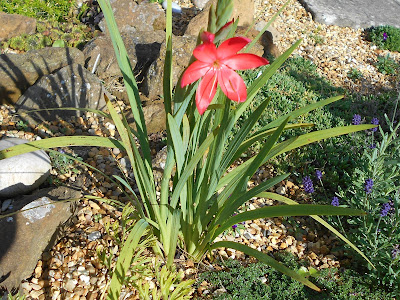Autumn can be one of the loveliest times of the year in our gardens and, although ours is small, we endeavour to brighten it up with the three f's: flowers, foliage or fruit.
Strictly speaking only two species currently in bloom are autumn flowering plants. We planted Hesperanthera coccinea this spring and it has performed well. In older books and many plant catalogues this South African member of the iris family is called Schizostylis coccinea. As for common names it may be listed under River Lily, Crimson Flag or Kaffir Lily, although the last of these name is now in disfavour as 'kaffir' is by some considered an offensive word. It is a little on the tender side but, unless we have a severe frost, it should be safe. It is closely related to Gladioli.
 |
Hesperanthera coccinea is currently doing well for us.
Stefen Hill, Daventry. 16 September, 2017
|
The other plant in this autumn flowering category is Sedum spectabile. Some gardeners, Bob Flowerdew for example, hate this plant and I admit there are more spectacular species, but I value it as a superb 'insect plant', attracting bees, hoverflies and butterflies by the score. Having said that, September was rather cool and wet; flower visitors have been fewer than expected.
 |
| Sedum spectabile in our back garden. 20 September, 2017 |
The other plants in bloom are really summer flowering species. They remain in flower either because they naturally have a long flowering season or because they have been cut back to induce a late floral display.
Shrubby Veronica species, formerly known as Hebe, bear racemes of flowers not unlike those of Buddleias. They do not attract butterflies in quite such abundance but some varieties such as 'Midsummer Beauty' aren't at all bad and are regularly visited in our garden by Small Tortoiseshell and Red Admiral butterflies. When time is available I snip off spent flowers to extend the display.
Some climbers are also producing late flowers. One is the Passion Flower, Passiflora caerulea. It does not look like producing fruits this year although last year it did so in profusion and I am currently nurturing one strong-growing seedling.
Shrubby Veronica species, formerly known as Hebe, bear racemes of flowers not unlike those of Buddleias. They do not attract butterflies in quite such abundance but some varieties such as 'Midsummer Beauty' aren't at all bad and are regularly visited in our garden by Small Tortoiseshell and Red Admiral butterflies. When time is available I snip off spent flowers to extend the display.
 |
Red Admiral butterfly on Veronica (ex-Hebe) flowers in our front garden.
16 September, 2017
|
Some climbers are also producing late flowers. One is the Passion Flower, Passiflora caerulea. It does not look like producing fruits this year although last year it did so in profusion and I am currently nurturing one strong-growing seedling.
 |
Passion flowers have an intriguing floral structure.
Our back garden. 20 September, 2017
|
'Black-eyed Susan' is a name applied to two completely different plants. One is Rudbeckia hirta, a sunflower-like annual. It is very popular but we do not grow it. Instead what we have is Thunbergia alata, a fast-growing climber in the Acanthaceae family (a surprise this, because it looks nothing like the familiar Bear's Breeches, Acanthus mollis). It is a perennial but is distinctly tender, so we grow it as an annual. It doesn't produce seeds for us so to propagate it we would need to take stem cuttings. Instead we simply buy new plants each year. We plan to erect a poly-tunnel on our allotment so I may have a go at cuttings.
 |
Black-eyed Susan has grown rampantly for us this year.
22 September, 2017
|
Dahlias are not the first plants to spring to mind when considering autumn colour but of course they usually do very well until the first frosts. All are natives of Mexico (the Dahlia is Mexico's national flower) and from the original wild species some 42 thousand varieties have been developed. As a general rule complex hybrids are poor for attracting pollinators but ours have done very well this year probably because we are growing varieties with a simple flower structure.
 |
| Still going strong. Dahlias in our back garden on 7 October, 2017 |
Next year? I aim to introduce some Sternbergia lutea into the front garden. This autumn or winter-flowering species is found wild from the Balearic Islands, through the Middle East and into Central Asia. I have heard it said that this plant was Christ's 'Lilies of the fields' but such a suggestion appears to be highly speculative.
Anyway, I'll give it a bash.
No comments:
Post a Comment